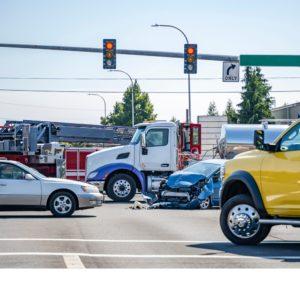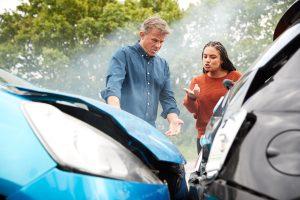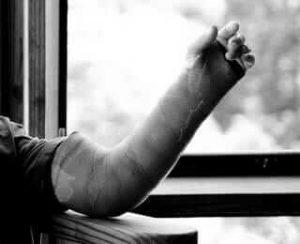
With multiple cars entering and exiting at any given moment, it’s no wonder intersections are where more than 50 percent of fatal and injurious car accidents occur, according to the U.S. Department of Transportation. There are hundreds of drivers on the road at one time, each with their own focus, distractions, and snap decisions to make in response to other drivers.
So, when a car accident happens, it may be challenging to determine who is at fault. Like all car accidents, in an intersection collision, the fault typically lies with the negligent driver (as opposed to, say, some third-party fault like an equipment malfunction).
Reasons for Intersection Accidents
According to a 2008 study published by the National Highway Traffic Safety Administration (NHTSA), 96% of intersection-related car accidents are attributable to drivers, while only less than 3% are due to environmental or vehicle factors. If a driver’s actions caused the accident, they would be considered at fault.
According to the NHTSA, the top reasons for intersection accidents are
- Inadequate surveillance
- False assumptions about another driver’s actions
- Turning with an obstructed view
- Illegal maneuvers
- Internal driver distraction
- Misjudgment of a gap or another driver’s speed
Inadequate Surveillance
Inadequate surveillance could mean you failed to look before making a maneuver, or it could mean you looked and did not see another car. Either way, about 44% of intersection accidents are caused by a driver not properly surveying his or her surroundings.
This is particularly important at an intersection when there are drivers coming and going in multiple directions in addition to bicycles and pedestrians.
False Assumptions About a Driver’s Actions
A driver may assume what another driver will do. The driver reacts based on that assumption and, thus a car accident occurs.
Turning with Obstructed View
Nearly 8% of accidents at intersections occur because of a driver making a turn with their view obstructed. Turning without being about to see what traffic is coming can be detrimental.
Illegal Maneuvers
When a driver makes an illegal maneuver, they are violating the law. They may be making an illegal U-turn, turning in a no-turn lane, passing another vehicle, changing lanes when it is not allowed, running a red light, or otherwise failing to yield the right of way.
Internal Distractions
Distractions inside the car more commonly lead to accidents than distractions outside the car (external distractions). A driver might be changing the radio station, looking for something, using their phone, or having a conversation rather than giving their full attention to the road.
Misjudging the Gap or Speed
Sometimes drivers may think there is more distance between them and another vehicle than exists. Other times, it may be that the driver misjudged another vehicle’s speed, which could lead them to accelerate, brake, or slow down incorrectly, causing a collision at the intersection.
For a free legal consultation, call 800-537-8185
Multiple People Can Be at Fault
When there is an accident at an intersection, the driver responsible for one of the above reasons (or others) is likely the at-fault driver. But keep in mind that when it comes to sharing the road, every driver must do whatever possible to prevent an accident. In many cases, you will find that more than one driver contributed to the cause of the accident, particularly at intersections.
The amount of fault you share in an accident could affect the compensation you receive in a personal injury lawsuit. Each state has its negligence laws which define how much compensation you are entitled to.
Most states, including Louisiana, use a form of comparative negligence law that reduces your financial award by the percentage of fault you hold. A few states bar you from receiving compensation if you are even 1% to blame for the accident.
Violating the Law When Car Accidents Occur
In general, it is usually much simpler to determine who is at fault when the intersection accident results from someone disobeying driving laws. Even if you failed to look properly or got distracted by a backseat conversation, if another driver was speeding or tailgating, they will likely bear the brunt of the fault. The offending driver would be considered negligent as a matter of law.
Right of Way Laws
One of the reasons figuring out who is at fault for an accident at an intersection can be so confusing is that drivers may not know or agree on who had the right of way. Right-of-way is clear when there are traffic lights and signs posted, but when there are not, a driver must follow the right-of-way laws of the state.
Though the specifics may vary by state, generally, when approaching an intersection with no control devices, the driver who gets there first has the right of way. If two drivers arrive at the intersection from different roads at approximately the same time, the driver on the left must yield to the driver on the right, allowing him to complete his maneuver before proceeding. The same applies to drivers at a four-way stop.
Drivers making a left turn are supposed to yield right of way to any vehicle approaching from the opposite direction.
Click to contact our personal injury lawyers today
Get Help with Your Intersection Car Accident from Morris Bart, LLC
If you were injured in a car accident at an intersection, a car accident lawyer at the Morris Bart law firm can help you file an insurance claim or lawsuit. We investigate your accident, obtain police reports, analyze evidence, and speak with witnesses to determine who is at fault after an accident at an intersection.
Call us today for a free consultation.
Questions?Call 800-537-8185
to find a Morris Bart office near you.




